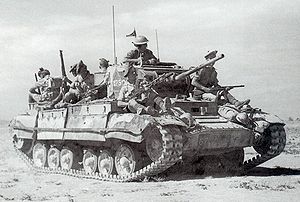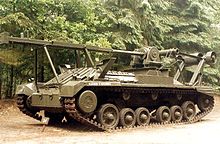Valentine tank
This article includes a list of references, related reading, or external links, but its sources remain unclear because it lacks inline citations. (March 2008) |
| Tank, Infantry, Valentine, Mk I - XI | |
|---|---|
 Valentine in North Africa carrying infantry from a Scottish regiment | |
| Type | Infantry tank |
| Place of origin | |
| Service history | |
| In service | 1940 - |
| Used by | British Army, Red Army |
| Wars | Second World War |
| Production history | |
| Designed | 1938 |
| Manufacturer | Vickers-Armstrong and others |
| Produced | 1940 - 1944 |
| No. built | 7,300 |
| Specifications | |
| Mass | 16-17 tonnes |
| Length | hull: 17 ft 9 in (5.4 m) |
| Width | 8 ft 8 in (2.6 m) |
| Height | 7 ft 6 in (2.2 m) |
| Crew | Mk I,II, IV, VI - XI: 3 (Commander, gunner, driver) Mk III, V: 4 (+ loader) |
| Armour | 8-65 mm |
Main armament | Mk I-VII: QF 2-pounder Mk VIII-X: QF 6-pounder Mk XI: QF 75 mm |
Secondary armament | Mk I-VII, X, XI: 7.92 mm BESA machine gun |
| Engine | Mk I: AEC A189 petrol Mk II, III, VI: AEC A190 diesel Mk IV, V, VII-XI: GMC 6004 diesel 131–210 hp (97–157 kW) |
| Suspension | coil sprung three-wheel bogies |
Operational range | 90 mi (145 km) |
| Maximum speed | 15 mph (24 km/h) |
The most numerous British manufactured tank of World War II, the Tank, Infantry, Mk III, Valentine was known mainly for its low cost and high reliability.
History
Based on the A10 Cruiser tank, the Valentine was privately designed by the Vickers-Armstrong corporation (hence its lack of an "A" designation) and was submitted to the War Office in February 1938. The development team tried to combine the weight of a cruiser tank (so that suspension and transmission parts of the A10 could be used) with the armour of an infantry tank, which resulted in a very small vehicle with a cramped interior and two-man turret. Though its armour was still weaker than the Matilda's and, due to a weaker engine, it shared the same top speed, the new design was much less expensive and easy to produce.
The War Office was initially deterred by the size of the turret and the crew compartment. However, concerned by the situation in Europe, it finally approved the design in April 1939. The vehicle reached trials in May 1940, which coincided with the loss of nearly all of Britain's equipment during the evacuation at Dunkirk. The trials were successful and the vehicle was rushed into production as Infantry Tank III Valentine.
Several versions exist concerning the source of the name Valentine. The most popular one says that the design was presented to the War Office at St. Valentine's Day (February 14). Some sources, however, claim that the exact date the design was submitted was February 10. According to another version, the tank was called Valentine in honour of Sir John Valentine Carden, the man who led the development of the A10 and many other Vickers vehicles. Yet another version says that Valentine is an acronym for Vickers-Armstrong Ltd Elswick & (Newcastle-upon) Tyne.
The Valentine remained in production until April 1944, becoming Britain's most mass produced tank during the war with 6,855 units manufactured in the UK (by Vickers, Metropolitan-Cammell Carriage and Wagon and Birmingham Railway Carriage and Wagon) and further 1,420 in Canada. They were the Commonwealth's main export to the Soviet Union under the Lend-lease Act, with 2,394 of the British models being sent and 1,388 of the Canadian models, and the remaining 30 being kept for training.
Combat history


The tank first saw combat during Operation Crusader, at which point it began to replace the Matilda. It was extensively used in the North African Campaign, earning a reputation as a reliable and well protected vehicle. However, the Valentine shared the common weakness of the British tanks of the period - its 2-pdr gun lacked high-explosive capability and soon became outdated as an anti-tank weapon too. The small size of the turret and of the turret ring made upgunning of the tank a difficult task. Although versions with the 6-pdr and then with the OQF 75 mm were developed, by the time they were available in significant numbers better tanks already reached the battlefield. Another weakness was small crew compartment and two-man turret. A larger turret with a loader position added was used in some of the 2-pdr armed versions, but in the upgunned variants the position had to be removed again.
By 1944, in the European Theatre the Valentine was almost completely replaced in the frontline units by the Churchill and the US-made Sherman. In the Pacific the tank was employed in limited numbers at least until May 1945.
In Soviet service, the Valentine was used from the Battle of Moscow until the end of the war. It was employed mostly on the southern fronts, [citation needed] both because of the proximity to the Persian supply route and in order to avoid using the tank in very cold climate. Although criticized for its speed and its weak gun, the Valentine was liked due to its small size, reliability and generally good armour protection.
Surviving tanks
Two Canadian-built Valentines survive.

Valentine Tank Mk VIIA, no. 838, built May 1943, was a Lend-Lease tank shipped to the Soviet Union. It fell through the ice of a boggy river near Telepino (Telepyne, Ukraine), during a Soviet counter-offensive on January 25, 1944. In 1990, a 74-year old villager helped locate the tank, and it was recovered and offered as a Glasnost-era gift to Canada. It was presented to the Canadian War Museum by independent Ukraine in 1992, and stand on display in the LeBreton Gallery.[1]
At least one Valentine exists in around 10 metres of water in Bracklesham Bay, south of Chichester in West Sussex. The hull and turret are clearly recognizable as it sits on a gravel mound. The remains of the tank used to be regularly dived by various diving clubs in the area.
Variants

Valentine I (Tank, Infantry, Mk III) (350 units produced)
The first model of the Valentine, it was not sent out due to problems from rushed production. The tank had riveted hull, was powered by AEC A189 135 hp gasoline engine and equipped with a 2 pdr. gun and a Besa coaxial machine gun. Its two-man turret forced the commander to also act as the guns loader.
Valentine II (Tank, Infantry, Mk III*) (700)

This model used AEC A190 131 hp diesel engine. In order to increase its range, an auxiliary external fuel tank was installed to the left of the engine compartment.
Valentine III

A larger turret was installed, allowing the addition of a dedicated loader to ease the duties of the commander. The side armour was reduced from 60 mm to 50 mm to save weight.
Valentine IV
A II using an American 138 hp GMC 6004 diesel engine and US-made transmission. Though it had slightly lower range, it was quieter and more reliable.
Valentine V
Valentine III with the GMC 6004 diesel engine and US-made transmission.
Valentine VI
Canadian-built version of IV. It used some Canadian and American mechanical parts. Late production vehicles had cast glacis detail. First few produced with a Besa coaxial machinegun, but soon replaced with a Browning 0.30 cal coaxial machinegun.
Valentine VII
Another Canadian version, it was essentially VI with internal changes, and a different radio set.
Valentine VIIA
VII with jettisonable fuel tanks, new studded tracks and protected headlights.
Valentine VIII
A III upgraded with the QF 6pdr gun. In order to fit it, the coaxial machinegun and the loader crewmember had to be removed. The side armour was reduced again.
Valentine IX

A V upgraded to the 6 pdr. gun. Similar armour reduction as the VIII. On late production units an upgraded, 165 hp version of the GMC 6004 diesel was installed, somewhat improving mobility.
Valentine X
A new turret design and 165 hp engine. A Besa coaxial machinegun was fitted again. Welded construction.
Valentine XI
An X upgraded with the OQF 75 mm gun and 210 hp version of the GMC 6004 diesel. Welded construction. Only served as a command tank.
Valentine DD

Valentine Mk V, IX and Mk XI, made amphibious by the use of Nicholas Straussler's Duplex Drive. Used by crews in training for the Sherman DD's of the Normandy Landings.
Valentine OP / Command
Observation post / command version with dummy gun and extra radios.
Valentine CDL (Canal Defense Light).
Turret was replaced with searchlight.
Valentine Scorpion II

Mine exploder, turretless with flail attachment. Never used operationally.
Valentine AMRA Mk Ib

Mine exploder with roller attachment. Never used operationally.
Valentine Snake
Mine exploder, using Snake mine clearing equipment. Few used operationally.
Valentine Bridgelayer

Turretless Mk II fitted with 34' x 9.5' class 30 scissors bridge. Several dozens were produced, some of them supplied to the USSR.
Valentine with 6pdr anti-tank mounting
Experimental vehicle built by Vickers-Armstrong to examine possibility of producing a simple tank destroyer by mounting 6pdr field carriage on hull in place of turret. Trials only, 1942.
Valentine Flamethrowers


Two Valentine tanks were modified by Petroleum Warfare Dept to determine which system was best for a tank-mounted flame projector. One used a projector ignited by cordite charges and one used projector operated by gas pressure. The fuel was carried in a trailer and the flame projector was mounted on the hull front. Trials started in 1942 and it showed that gas-operated system was better. From this test installation was developed the Crocodile equipment for the Churchill flamethrower used in the NW Europe campaign in 1944-45.
Valentine 7.92in flame mortar

Experimental vehicle with turret replaced by fixed heavy mortar intended to project 25 lb TNT incendiary shells to demolish concrete emplacements. Trials only by Petroleum Warfare Dept, 1943-45. Maximum range of this weapon was 2000 yards and effective range was 400 yards.
Vehicles based on chassis
- SP 17pdr, Valentine, Mk I, Archer
- Carrier, Valentine, 25pdr gun Mk I, Bishop
- Tank, Infantry, Valiant (A38)
See also
Notes
- ^ Fred Gaffen ed., Canadian Valentine Tank MK VIIA, Canadian War Museum Fact Sheet No. 5.
References
- M. Baryatinskiy - Valentine Infantry Tank, Modelist-Konstruktor, Bronekollektsiya 05-2002 (М. Барятинский - Пехотный танк Валентайн, Моделист-Конструктор, Бронеколлекция 05-2002).
- Peter Chamberlain, Chris Ellis - British and American Tanks of World War Two, 2004.
